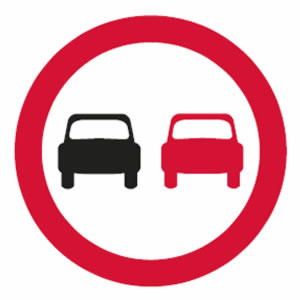Often it is down to the drivers discretion on whether they should overtake or not and depends on the vehicle being driven and the particular road. Certain segments of a road or an entire road may be illegal to overtake another vehicle.
The no overtaking rule is signified by no overtaking signs and / or road markings and can be on any type of road except dual carriageways or motorways. A no overtaking road sign isn’t always used in conjunction with no overtaking road markings.
Road markings may also be worn or damaged and can be especially difficult to see for a practical driving test candidate.
No overtaking sign
The no overtaking road sign is circular with a red border meaning that it is giving drivers an order. As the no overtaking sign is regulatory, it is illegal to overtake. The no overtaking restriction ends when the lines in the road change from a continuous white line, to a broken line. No overtaking signs are often located on bends, dips in the road or where there are hills.
Overtaking can be a dangerous manoeuvre and should only be performed if absolutely necessary. Many drivers each year unnecessarily overtake other vehicles, resulting in an accident.
If overtaking is necessary, anticipation, planning and driving routines such as the Mirror Signal Manoeuvre (MSM) or MSPSL routine must be used. See the overtaking tutorial for further information.

No overtaking road markings
No overtaking road markings are used to tell drivers when they may or may not overtake. The diagram below illustrates a typical single carriageway road. A to D represents road markings typically found on many UK roads.
-
Road A
The broken line down the centre of the road informs drivers that it is legal for vehicles on either side of the carriageway to overtake. Although it is legal, it doesn’t necessarily mean it is safe to overtake.
-
Road B
The broken line next to the red car informs the driver of the red car it is legal to overtake. The solid line next to the yellow car prohibits overtaking.
-
Road C
The opposite applies here. The red car is prohibited from overtaking where as it is legal for the yellow car to do so.
-
Road D
With two continuous white lines, no overtaking is permitted for vehicles on either side of the road.

As can be seen, no overtaking is permitted where a solid line is closest to the vehicle. Hatched road markings or chevron markings may also be surrounded with a broken line or a solid line. Those surrounded by a solid line are prohibited from entering or crossing.
Penalty and fines for overtaking
If caught overtaking where no overtaking signs are in place or crossing a continuous solid white line results in three penalty points on the drivers licence and a £60 fine.
A driver may still receive a penalty if it is legal to overtake but the manoeuvre is performed carelessly or dangerously. Dangerous or careless driving results in a court summons and will see a driver acquire from 3 to 11 penalty points for dangerous driving and 3 – 9 points for careless driving. Potential licence disqualification and an unlimited fine may be imposed depending on the circumstances.
When can I overtake on a no overtaking restriction
Where no overtaking restriction is in place, it is legal to cross a solid white line to enter a property or side road, to manoeuvre and pass a stationary vehicle that is preventing you from driving on your side of the road, to overtake cyclists, a horse or a road works vehicle moving at 10 mph (16 km/h) or less.
Overtaking and the driving test
The first rule of overtaking is only do so if it is legal, safe and necessary. You may be required to overtake on a dual carriageway if they are a part of the driving test routes, other than this, it’s not too likely you will need to overtake another moving vehicle.
Overtaking and passing parked cars along with cyclists is highly likely to happen however. Although this is legal in a restricted no overtaking area, it is likely to be extra hazardous as the rule has been applied in that area. Only overtake if you are absolutely sure it is safe to do so, or wait until you are sure. Don’t put pressure on yourself by thinking that the driving examiner will become impatient. The driving test is about driving safely and making progress only if it is safe to do so.
